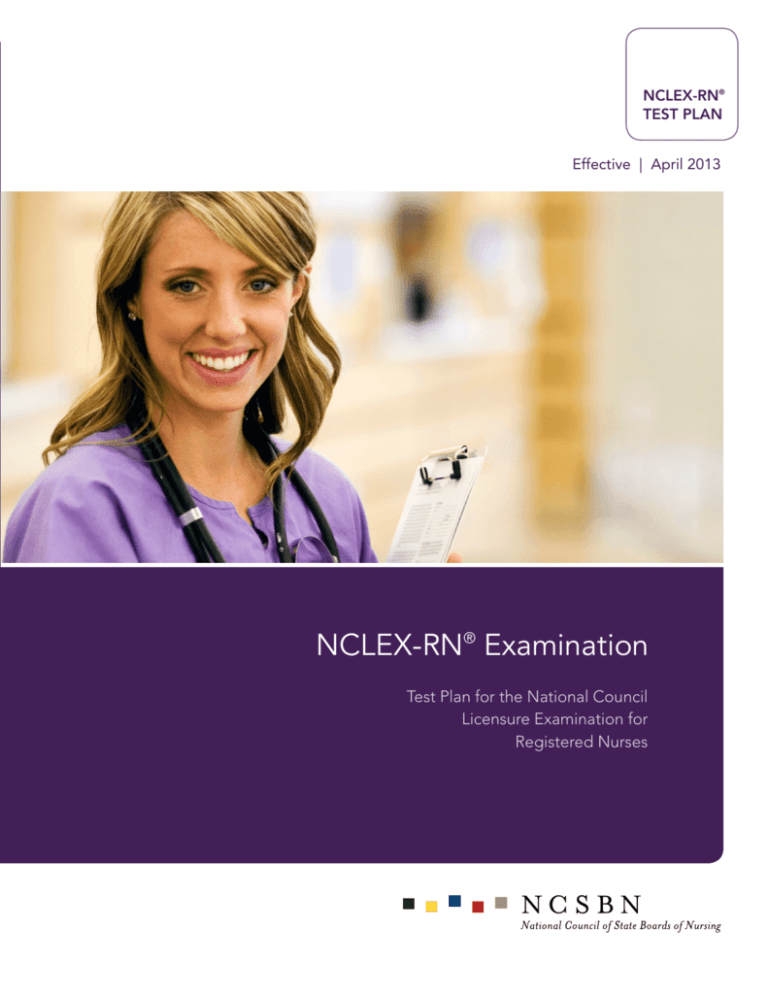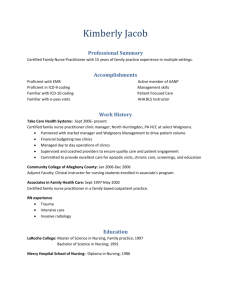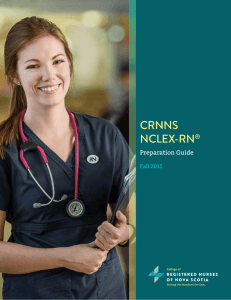
NCLEX-RN®
TEST PLAN
Effective | April 2013
NCLEX-RN® Examination
Test Plan for the National Council
Licensure Examination for
Registered Nurses
Mission Statement
The National Council of State Boards of Nursing (NCSBN®) provides education, service and research through collaborative
leadership to promote evidence-based regulatory excellence for patient safety and public protection.
Copyright ©2012 National Council of State Boards of Nursing, Inc. (NCSBN®)
All rights reserved. NCSBN®, NCLEX®, NCLEX-RN®, NCLEX-PN®, NNAAP®, MACE®, Nursys® and TERCAP® are registered
trademarks of NCSBN and this document may not be used, reproduced or disseminated to any third party without written permission from NCSBN.
Permission is granted to boards of nursing to use or reproduce all or parts of this document for licensure related purposes
only. Nonprofit education programs have permission to use or reproduce all or parts of this document for educational
purposes only. Use or reproduction of this document for commercial or for-profit use is strictly prohibited. Any authorized
reproduction of this document shall display the notice: “Copyright by the National Council of State Boards of Nursing,
Inc. All rights reserved.” Or, if a portion of the document is reproduced or incorporated in other materials, such written
materials shall include the following credit: “Portions copyrighted by the National Council of State Boards of Nursing,
Inc. All rights reserved.”
Address inquiries in writing to NCSBN Permissions, 111 E. Wacker Drive, Suite 2900, Chicago, IL 60601-4277. Suggested
Citation: National Council of State Boards of Nursing.
1
2013 NCLEX-RN® Test Plan
2013 NCLEX-RN® Test Plan
National Council Licensure Examination for Registered Nurses
(NCLEX-RN® Examination)
Introduction
Entry into the practice of nursing is regulated by the licensing authorities within each of the National Council
of State Boards of Nursing (NCSBN®) member board jurisdictions (state, commonwealth, and territorial boards
of nursing). To ensure public protection, each jurisdiction requires candidates for licensure to meet set requirements that include passing an examination that measures the competencies needed to perform safely and effectively as a newly licensed, entry-level registered nurse. NCSBN develops a licensure examination, the National
Council Licensure Examination for Registered Nurses (NCLEX-RN®), which is used by member board jurisdictions
to assist in making licensure decisions.
Several steps occur in the development of the NCLEX-RN Test Plan. The first step is conducting a practice analysis that is used to collect data on the current practice of the entry-level nurse (Report of Findings from the 2011
RN Practice Analysis: Linking the NCLEX-RN® Examination to Practice; NCSBN, 2012). Twelve thousand newly
licensed registered nurses are asked about the frequency and importance of performing 141 nursing care activities. Nursing care activities are then analyzed in relation to the frequency of performance, impact on maintaining
client safety, and client care settings where the activities are performed. This analysis guides the development of
a framework for entry-level nursing practice that incorporates specific client needs as well as processes fundamental to the practice of nursing. The second step is the development of the NCLEX-RN Test Plan, which guides
the selection of content and behaviors to be tested.
The NCLEX-RN Test Plan provides a concise summary of the content and scope of the licensing examination.
It serves as a guide for examination development as well as candidate preparation. The NCLEX® examination
assesses the knowledge, skills and abilities that are essential for the entry-level nurse to use in order to meet the
needs of clients requiring the promotion, maintenance or restoration of health. The following sections describe
beliefs about people and nursing that are integral to the examination, cognitive abilities that will be tested in
the examination and specific components of the NCLEX-RN Test Plan.
Beliefs
Beliefs about people and nursing underlie the NCLEX-RN Test Plan. People are finite beings with varying capacities to function in society. They are unique individuals who have defined systems of daily living reflecting their
values, motives and lifestyles. People have the right to make decisions regarding their health care needs and
to participate in meeting those needs. The profession of nursing makes a unique contribution in helping clients
(individual, family, or group) achieve an optimal level of health in a variety of settings. For the purposes of the
NCLEX Examination, a client is defined as the individual, family, or group which includes significant others and
population.
Nursing is both an art and a science, founded on a professional body of knowledge that integrates concepts
from the liberal arts and the biological, physical, psychological and social sciences. It is a learned profession
2
2013 NCLEX-RN® Test Plan
based on knowledge of the human condition across the life span and the relationships of an individual with others and within the environment. Nursing is a dynamic, continually evolving discipline that employs critical thinking to integrate increasingly complex knowledge, skills, technologies, and client care activities into evidencebased nursing practice. The goal of nursing for client care is preventing illness and potential complications;
protecting, promoting, restoring, and facilitating comfort; health; and dignity in dying.
The registered nurse provides a unique, comprehensive assessment of the health status of the client, applying
principles of ethics, client safety, health promotion and the nursing process, the nurse then develops and implements an explicit plan of care. The nurse assists clients to promote health, cope with health problems, adapt to
and/or recover from the effects of disease or injury, and support the right to a dignified death. The registered
nurse is accountable for abiding by all applicable member board jurisdiction statutes related to nursing practice.
Classification of Cognitive Levels
Bloom’s taxonomy for the cognitive domain is used as a basis for writing and coding items for the examination
(Bloom, et al., 1956; Anderson & Krathwohl, 2001). Since the practice of nursing requires application of knowledge, skills and abilities, the majority of items are written at the application or higher levels of cognitive ability,
which requires more complex thought processing.
Test Plan Structure
The framework of Client Needs was selected for the examination because it provides a universal structure for
defining nursing actions and competencies, and focuses on clients in all settings.
Client Needs
The content of the NCLEX-RN Test Plan is organized into four major Client Needs categories. Two of the four
categories are divided into subcategories:
Safe and Effective Care Environment
Management of Care
Safety and Infection Control
Health Promotion and Maintenance
Psychosocial Integrity
Physiological Integrity
Basic Care and Comfort
Pharmacological and Parenteral Therapies
Reduction of Risk Potential
Physiological Adaptation
3
2013 NCLEX-RN® Test Plan
Integrated Processes
The following processes are fundamental to the practice of nursing and are integrated throughout the Client
Needs categories and subcategories:
Nursing Process – a scientific, clinical reasoning approach to client care that includes assessment,
analysis, planning, implementation and evaluation.
Caring – interaction of the nurse and client in an atmosphere of mutual respect and trust. In this
collaborative environment, the nurse provides encouragement, hope, support and compassion to
help achieve desired outcomes.
Communication and Documentation – verbal and nonverbal interactions between the nurse and
the client, the client’s significant others and the other members of the health care team. Events and
activities associated with client care are recorded in written and/or electronic records that demonstrate adherence to the standards of practice and accountability in the provision of care.
Teaching/Learning – facilitation of the acquisition of knowledge, skills and attitudes promoting a
change in behavior.
Distribution of Content
The percentage of test questions assigned to each Client Needs category and subcategory of the NCLEX-RN
Test Plan is based on the results of the Report of Findings from the 2011 RN Practice Analysis: Linking the
NCLEX-RN® Examination to Practice (NCSBN, 2012), and expert judgment provided by members of the NCLEX®
Examination Committee.
Client Needs
Percentage of Items from Each
Category/Subcategory
Safe and Effective Care Environment
Management of Care
17-23%
Safety and Infection Control
9-15%
Health Promotion and Maintenance
6-12%
Psychosocial Integrity
6-12%
Physiological Integrity
Basic Care and Comfort
6-12%
Pharmacological and Parenteral
Therapies
12-18%
Reduction of Risk Potential
9-15%
Physiological Adaptation
11-17%
4
2013 NCLEX-RN® Test Plan
Distribution of Content for the NCLEX-RN® Test Plan
Physiological
Adaptation
14%
Management of Care
20%
Reduction of Risk
Potential
12%
Safety and Infection
Control
12%
Pharmacological and
Parenteral Therapies
15%
Health Promotion and
Maintenance
9%
Psychosocial
Integrity
9%
Basic Care and Comfort
9%
NCLEX-RN examinations are administrated adaptively in variable length format to target candidate-specific ability. To accommodate possible variations in test length, content area distributions of the individual examinations
may differ up to ±3% in each category.
Overview of Content
All content categories and subcategories reflect client needs across the life span in a variety of settings.
Safe and Effective Care Environment
The nurse promotes achievement of client outcomes by providing and directing nursing care that enhances the
care delivery setting in order to protect clients and health care personnel.
Management of Care – providing and directing nursing care that enhances the care delivery set-
ting to protect clients and health care personnel.
Related content includes but is not limited to:
Advance Directives
Continuity of Care
Advocacy
Establishing Priorities
Assignment, Delegation and Supervision
Ethical Practice
Case Management
Informed Consent
Client Rights
Information Technology
Collaboration with Interdisciplinary Team
Legal Rights and Responsibilities
Concepts of Management
Performance Improvement (Quality Improvement)
Confidentiality/Information Security
Referrals
5
2013 NCLEX-RN® Test Plan
Safety and Infection Control – protecting clients and health care personnel from health and envi-
ronmental hazards.
Related content includes but is not limited to:
Accident/Error/Injury Prevention
Emergency Response Plan
Ergonomic Principles
Handling Hazardous and Infectious Materials
Home Safety
Reporting of Incident/Event/Irregular
Occurrence/Variance
Safe Use of Equipment
Security Plan
Standard Precautions/TransmissionBased Precautions/Surgical Asepsis
Use of Restraints/Safety Devices
Health Promotion and Maintenance
The nurse provides and directs nursing care of the client that incorporates the knowledge of expected growth
and development principles; prevention and/or early detection of health problems, and strategies to achieve
optimal health.
Related content includes but is not limited to:
Aging Process
High Risk Behaviors
Ante/Intra/Postpartum and Newborn Care
Lifestyle Choices
Developmental Stages and Transitions
Self-Care
Health Promotion/Disease Prevention
Techniques of Physical Assessment
Health Screening
Psychosocial Integrity
The nurse provides and directs nursing care that promotes and supports the emotional, mental and social wellbeing of the client experiencing stressful events, as well as clients with acute or chronic mental illness.
Related content includes but is not limited to:
Abuse/Neglect
Family Dynamics
Behavioral Interventions
Grief and Loss
Chemical and Other Dependencies/
Substance Use Disorder
Mental Health Concepts
Religious and Spiritual Influences on Health
Coping Mechanisms
Sensory/Perceptual Alterations
Crisis Intervention
Stress Management
Cultural Awareness/Cultural Influences
on Health
End of Life Care
Support Systems
Therapeutic Communication
Therapeutic Environment
6
2013 NCLEX-RN® Test Plan
Physiological Integrity
The nurse promotes physical health and wellness by providing care and comfort, reducing client risk potential
and managing health alterations.
Basic Care and Comfort - providing comfort and assistance in the performance of activities of daily
living.
Related content includes but is not limited to:
Assistive Devices
Nutrition and Oral Hydration
Elimination
Personal Hygiene
Mobility/Immobility
Rest and Sleep
Non-Pharmacological Comfort Interventions
Pharmacological and Parenteral Therapies - providing care related to the administration of medica-
tions and parenteral therapies.
Related content includes but is not limited to:
Adverse Effects/Contraindications/Side
Effects/Interactions
Expected Actions/Outcomes
Medication Administration
Blood and Blood Products
Parenteral/Intravenous Therapies
Central Venous Access Devices
Pharmacological Pain Management
Dosage Calculation
Total Parenteral Nutrition
Reduction of Risk Potential - reducing the likelihood that clients will develop complications or
health problems related to existing conditions, treatments or procedures.
Related content includes but is not limited to:
Changes/Abnormalities in Vital Signs
Diagnostic Tests
Laboratory Values
System Specific Assessments
Potential for Alterations in Body Systems
Therapeutic Procedures
Potential for Complications from Surgical
Procedures and Health Alterations
Potential for Complications of Diagnostic
Tests/Treatments/Procedures
Physiological Adaptation - managing and providing care for clients with acute, chronic or life
threatening physical health conditions.
Related content includes but is not limited to:
Alterations in Body Systems
Medical Emergencies
Fluid and Electrolyte Imbalances
Pathophysiology
Hemodynamics
Unexpected Response to Therapies
Illness Management
7
2013 NCLEX-RN® Test Plan
Administration of the NCLEX-RN® Examination
The NCLEX-RN Examination is administered to candidates by computerized adaptive testing (CAT). CAT is a
method of delivering examinations that uses computer technology and measurement theory. With CAT, each
candidate’s examination is unique because it is assembled interactively as the examination proceeds. Computer
technology selects items to administer that match the candidate’s ability. The items, which are stored in a large
item pool, have been classified by test plan category and level of difficulty. After the candidate answers an item,
the computer calculates an ability estimate based on all of the previous answers the candidate selected. The
next item administered is chosen to measure the candidate’s ability in the appropriate test plan category. This
process is repeated for each item, creating an examination tailored to the candidate’s knowledge and skills while
fulfilling all NCLEX-RN Test Plan requirements. The examination continues with items selected and administered
in this way until a pass or fail decision is made.
All registered nurse candidates must answer a minimum of 75 items. The maximum number of items that a
registered nurse candidate may answer is 265 during the allotted six-hour time period. The maximum six-hour
time limit to complete the examination includes the tutorial, sample questions and all breaks. Candidates may
be administered multiple choice items as well as items written in alternate formats. These formats may include
but are not limited to multiple response, fill-in-the-blank calculation, ordered response, and/or hot spots. All
item types may include multimedia such as charts, tables, graphics, sound and video. All items go through an
extensive review process before being used as items on the examination.
More information about the NCLEX examination, including CAT methodology, items, the candidate bulletin and
Web tutorials can be found on the the NCSBN website: http://www.ncsbn.org.
Examination Security and Confidentiality
Any candidate that violates test center regulations or rules, or engages in irregular behavior, misconduct and/or
does not follow a test center administrator’s warning to discontinue inappropriate behavior may be dismissed
from the test center. Additionally, exam results may be withheld or cancelled and the licensing board may take
other disciplinary action such as denial of a license and/or disqualifying the candidate from future registrations
for licensure. Refer to the current candidate bulletin for more information.
Candidates should be aware and understand that the disclosure of any examination materials including the
nature or content of examination items, before, during or after the examination is a violation of law. Violations
of confidentiality and/or candidates’ rules can result in criminal prosecution or civil liability and/or disciplinary
actions by the licensing agency including the denial of licensure. Disclosure of examination materials includes
but is not limited to discussing examination items with faculty, friends, family, or others.
8
2013 NCLEX-RN® Test Plan
Bibliography
Anderson, L. W., & Krathwohl, D. R. (eds). (2001). A taxonomy for learning, teaching, and assessing. A revision of
Bloom’s taxonomy of educational objectives. New York: Addison Wesley Longman, Inc.
Bloom, B. S., Engelhart, M. D., Furst, E. J., Hill, W. H., & Krathwohl, D. R. (1956). Taxonomy of educational
objectives: The classification of educational goals. Handbook I. Cognitive Domain. New York: David McKay.
National Council of State Boards of Nursing. (2012). Report of findings from the 2011 RN practice analysis:
linking the NCLEX-RN® examination to practice. Chicago: Author.
National Council of State Boards of Nursing. (2011). Model nursing administrative rules. Chicago: Author.
National Council of State Boards of Nursing. (2011). Model nursing practice act. Chicago: Author.
National Council of State Boards of Nursing (NCSBN®)
111 E. Wacker Drive, Suite 2900
Chicago, IL 60601-4277 USA
312.525.3600 | www.ncsbn.org
+1.312.525.3600 International Calls
866.293.9600 Testing Services Toll-Free
312.279.1036 Testing Services Fax







